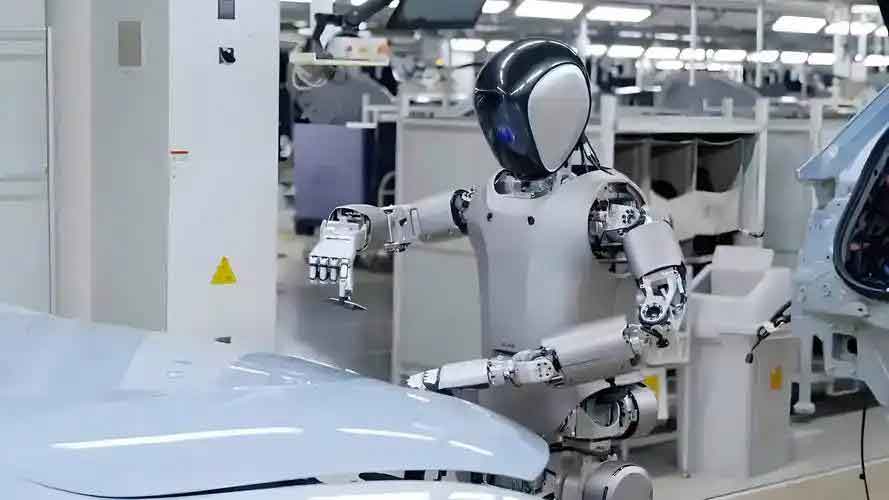
Shanghai-based Zhiyuan Innovation Technology announced on March 10th the successful production of over 1,000 units of its general-purpose embodied robots, signaling a critical juncture for the humanoid robot industry. This milestone precedes the company’s “1+4 Zhiyuan Qiyuan Large Model” launch event scheduled for March 14th in Zhuhai, featuring the Lingxi X2 embodied intelligent humanoid robot. Industry experts view this development as a decisive transition from laboratory prototypes to commercial viability for humanoid robots.
- Production Milestone Demonstrates Manufacturing Readiness
Zhang Xinyuan, Executive General Manager of Beijing Kefangde Technology Development, emphasized the significance: “Zhiyuan’s achievement of 1,000 units demonstrates matured capabilities across R&D, production processes, and supply chain management for humanoid robots. This breakthrough accelerates commercial adoption timelines for humanoid robots industry-wide and will catalyze increased investment into humanoid robotics innovation.” The production benchmark validates scalability in manufacturing humanoid robots, addressing previous bottlenecks in component sourcing and assembly precision that hindered mass production of sophisticated humanoid robots.
- Accelerated Technological Advancements
Chinese enterprises have achieved consecutive breakthroughs in humanoid robot development this year. In January, Zhiyuan conducted a batch delivery ceremony in Changsha for its Lingxi X1 humanoid robot systems. On March 10th, the company unveiled its embodied intelligence large model GO-1, significantly enhancing decision-making capabilities for humanoid robots operating in complex environments. Concurrently, Xiaomi Corporation has intensified patent filings and recruitment for its humanoid robot division, with operational updates expected during March-April. Xpeng Robotics has deployed humanoid robots in its Guangzhou facility, targeting L3-level autonomous production by 2026. Companies including Unitree Robotics, UBTECH Robotics, and Shenzhen Zhongqing Robotics have all reported substantial progress in humanoid robot development, indicating broad-based acceleration across China’s humanoid robot ecosystem.
- Policy Frameworks Catalyze Industry Growth
China’s 2025 Government Work Report formally incorporated “embodied intelligence” into national policy directives for the first time, providing strategic alignment for humanoid robot development. Over 20 municipalities have enacted explicit humanoid robot development initiatives, with Shenzhen emerging as a manufacturing hub housing 51,100 robotics enterprises and generating industrial output exceeding ¥170 billion. This policy-technological convergence creates favorable conditions for rapid scaling of humanoid robot production nationwide, establishing regulatory sandboxes and fiscal incentives specifically targeting humanoid robot industrialization.
- Market Projections Signal Exponential Growth
Financial institutions forecast transformative market expansion for humanoid robots. Goldman Sachs’ latest robotics industry report projects the global humanoid robot market will reach $38 billion by 2035, with supply chain enterprises positioned for early-stage value capture. Analysis from Kaiyuan Securities indicates potential mass production breakthroughs for domestic and international humanoid robots during 2025-2026. Wanlian Securities’ research notes that 2025 will likely witness dual catalysts of technological maturation and production scaling across the humanoid robot sector, with Zhiyuan’s GO-1 model potentially establishing new ecosystem standards for humanoid robot cognitive capabilities.
- Supply Chain Companies Establish Strategic Positioning
Multiple listed companies have secured early-mover advantages within the humanoid robot value chain. Yuhuan CNC Machine Tool confirmed business partnerships with reducer manufacturers for planetary gear components used in humanoid robot joints. Lens Technology, as a core supplier to Zhiyuan, participates in manufacturing and testing critical modules including joint assemblies, DCU controllers, and grippers for the Lingxi X1 humanoid robot. The company provides comprehensive vertical integration services covering design-to-production for humanoid robots and collaborates with leading domestic and North American humanoid robot developers on joint modules and full-system assembly.
Additional public companies disclosed humanoid robot initiatives through investor communications portals. SoftBank-powered SoftStone Tianqing Robotics launched its Tianhe C1 interactive educational humanoid robot in January. Ningbo-based PIA Group has commenced small-batch testing of humanoid robot components with clients. Keliy Sensor established dedicated humanoid robot R&D divisions actively engaging manufacturers across the humanoid robot landscape. These developments confirm systematic supply chain preparation for impending humanoid robot production volumes.
The collective progress in humanoid robot manufacturing capabilities establishes new industry benchmarks while unlocking substantial growth potential for upstream suppliers. Zhang Xinyuan observed: “Mass production of humanoid robots will directly drive order volume surges for component specialists. Collaborative R&D partnerships between humanoid robot manufacturers and supply chain leaders will accelerate performance improvements while reducing production costs.” As technological barriers diminish and policy support intensifies, the transition toward industrial-scale manufacturing of humanoid robots represents a pivotal inflection point for global robotics advancement.
